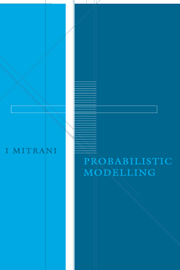1 - Introduction to probability theory
Published online by Cambridge University Press: 05 June 2012
Summary
Unpredictability and non-determinism are all around us. The future behaviour of any system—from an elementary particle to a complex organism—may follow a number of possible paths. Some of these paths may be more likely than others, but none is absolutely certain. Such unpredictable behaviour, and the phenomena that cause it, are usually described as ‘random’. Whether randomness is in the nature of reality, or is the result of imperfect knowledge, is a philosophical question which need not concern us here. More important is to learn how to deal with randomness, how to quantify it and take it into account, so as to be able to plan and make rational choices in the face of uncertainty.
The theory of probabilities was developed with this object in view. Its domain of applications, which was originally confined mainly to various games of chance, now extends over most scientific and engineering disciplines.
This chapter is intended as a self-contained introduction; it describes all the concepts and results of probability theory that will be used in the rest of the book. Examples and exercises are included. However, it is impossible to provide a thorough coverage of a major branch of mathematics in one chapter. The reader is therefore assumed to have encountered at least some of this material already.
- Type
- Chapter
- Information
- Probabilistic Modelling , pp. 1 - 46Publisher: Cambridge University PressPrint publication year: 1997



